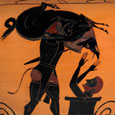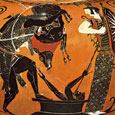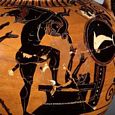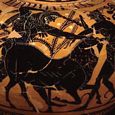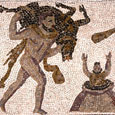HUS ERYMANTHIOS
Greek Name
Ὑς Ερυμανθιος
Transliteration
Hus Erymanthios
Latin Spelling
Hus Erymanthius
Translation
Erymanthian Boar
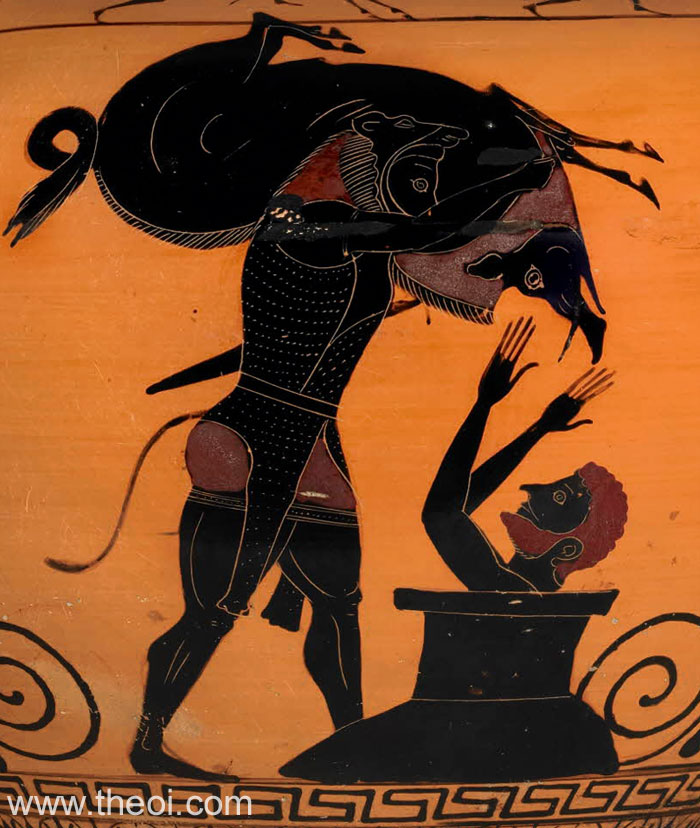
THE HUS ERYMANTHIOS (Erymanthian Boar) was a gigantic boar which ravaged the farmlands of Psophis in western Arkadia (Arcadia). Herakles (Heracles) was sent to capture it as one of his Twelve Labours. After chasing the boar through the deep winter snows of Mount Erymanthos, he netted it and brought it back alive to Eurystheus. The king, terrified at the sight of the deadly beast, leapt into a buried pithos jar for safety.
The boar may have once been assigned a Constellation like the other beasts of Herakles' Twelve Labours.
FAMILY OF THE BOAR
PARENTS
Nowhere stated, perhaps related to the Kalydonian Boar
ENCYCLOPEDIA
ERYMANTHIAN BOAR. This animal, which Heracles was ordered to bring alive, had descended from mount Erymanthus (according to others, from mount Lampe,) into Psophis. Heracles chased him through the deep snow, and having thus worn him out, he caught him in a net, and carried him to Mycenae. (Apollod. ii. 5. § 4; Diod. iv. 12.) Other traditions place the hunt of the Erymanthian boar in Thessaly, and some even in Phrygia. (Eurip. Herc. Fur. 368; Hygin. Fab. 30.) It must be observed that this and subsequent labours of Heracles are connected with other subordinate ones, called Parerga, and the first of these parerga is the fight of Heracles with the Centaurs.
Source: Dictionary of Greek and Roman Biography and Mythology.
CLASSICAL LITERATURE QUOTES
ERYMANTHIAN BOAR THE FOURTH LABOUR OF HERACLES
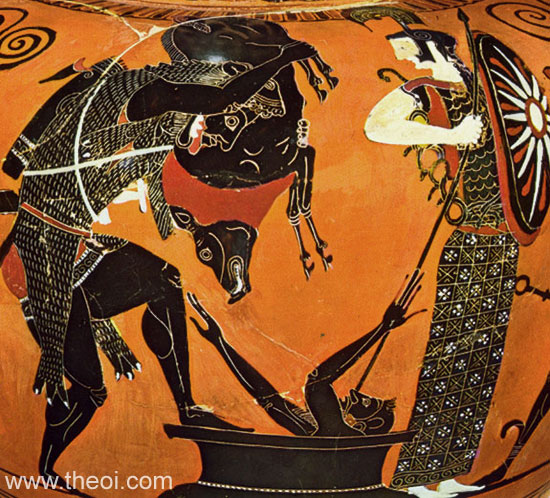
Pseudo-Apollodorus, Bibliotheca 2. 83 (trans. Aldrich) (Greek mythographer C2nd A.D.) :
“For his [Herakles’ (Heracles')] fourth labor Eurystheus told him to bring back alive the Erymanthian boar. This animal would set out from the mountain called Erymanthos (Erymanthus), and abuse the land of Psophis. As Herakles was travelling through Pholoe, he stopped with kentauros (centaur) named Pholos (Pholus) . . . [Pholos entertained Herakles but the other Kentauroi (Centaurs) stormed his encampment and were slain by Herakles.]
When Herakles returned to Pholoe, he found Pholos dead [having dropped one of Herakles poisonous arrows on his own foot], so he buried him and proceeded to find the boar. By shouting he routed it from a clump of trees, forced it into heavy snow until it weakened, then snared it with a noose and took it back to Mykenai."
Sophocles, Trachinae 1097 (Greek tragedy C5th B.C.) :
"You [Herakles] tamed the beast in Erymanthia."
Quintus Smyrnaeus, Fall of Troy 6. 220 ff (trans. Way) (Greek epic C4th A.D.) :
"[Depicted on the shield of Herakles' son Eurypylos :] Thereby was wrought the mighty tameless Boar with foaming jaws; real seemed the pictured thing, as by Aleides' [Herakles'] giant strength the brute was to Eurystheus living borne on high."
Ovid, Metamorphoses 9. 191 (trans. Melville) (Roman epic C1st B.C. to C1st A.D.) :
"The Centauri (Centaurs) quailed before me [Herakles] and the Boar that wasted Arcadiae (Arcadia)."
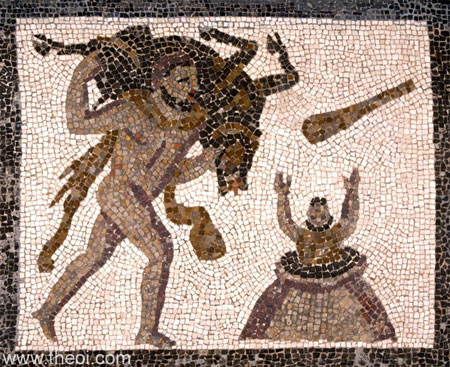
Ovid, Heroides 9. 87 ff (trans. Showerman) (Roman poetry C1st B.C. to C1st A.D.) :
"[Herakles] told of the deeds . . . how the Tegeaean boar has his lair on cypress-bearing Erymanthus, and afflicts the ground with his vast weight."
Seneca, Hercules Furens 228 ff (trans. Miller) (Roman tragedy C1st A.D.) :
"[The labours of Herakles :] The shaggy boar of Maenalus, whose wont it was on the thick-wooded heights of Erymanthus to harry the groves of Arcady."
Statius, Thebaid 4. 297 ff (trans. Mozley) (Roman epic C1st A.D.) :
"The mountains [of Arcadia] famed for Hercules' might, Erymanthos home of monsters [i.e. the boar], and Stymphalos with its clanging bronze [i.e. the labour of the birds]."
Statius, Thebaid 8. 746 ff :
"Lifts him still breathing from the dust, and returns with him on his left shoulder, staining his back with blood from the stricken wound: in such wise did the Tirynthian [Herakles] return from the Arcadian lair, when the brought home to applauding Argos the captive [Erymanthian] Boar."
Suidas s.v. Dryopes (trans. Suda On Line) (Byzantine Greek Lexicon C10th A.D.) :
"Dryopes : A lawless people from the region of Delphoi (Delphi) whom Herakles resettled. For at the time when he was fetching the Erymanthian boar he sought food from them but they did not give him any."
ANCIENT GREEK ART
SOURCES
GREEK
- Sophocles, Trachinae - Greek Tragedy C5th B.C.
- Apollodorus, The Library - Greek Mythography C2nd A.D.
- Quintus Smyrnaeus, Fall of Troy - Greek Epic C4th A.D.
ROMAN
- Ovid, Metamorphoses - Latin Epic C1st B.C. - C1st A.D.
- Ovid, Heroides - Latin Poetry C1st B.C. - C1st A.D.
- Seneca, Hercules Furens - Latin Tragedy C1st A.D.
- Statius, Thebaid - Latin Epic C1st A.D.
BYZANTINE
- Suidas, The Suda - Byzantine Greek Lexicon C10th A.D.
BIBLIOGRAPHY
A complete bibliography of the translations quoted on this page.
